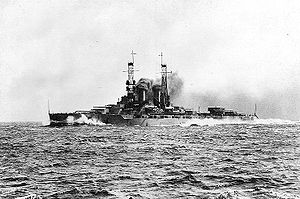 Wyoming as completed
| |
| Class overview | |
|---|---|
| Name | Wyoming-class battleship |
| Builders | |
| Operators | |
| Preceded by | Florida class |
| Succeeded by | New York class |
| Built | 1910–1912 |
| In commission | 1912–1947 |
| Completed | 2 |
| Retired | 2 |
| General characteristics (As built)[a] | |
| Type | Dreadnought battleship |
| Displacement | |
| Length | |
| Beam | 93 ft 3 in (28.42 m) |
| Draft |
|
| Installed power |
|
| Propulsion |
|
| Speed | 20.5 kn (38.0 km/h; 23.6 mph) |
| Range | 8,000 nmi (9,210 mi; 14,820 km) at 10 kn (19 km/h; 12 mph) |
| Complement | 1,063 officers and enlisted |
| Armament |
|
| Armor | |
The Wyoming class was a pair of dreadnought battleships built for the United States Navy. Wyoming and Arkansas were authorized in early 1909, and were built between 1910 and 1912. These were the fourth dreadnought design of the US Navy, but only an incremental improvement over the preceding Florida class, and the last US battleships to use 12-inch guns. The primary changes were the adoption of a more powerful 12 in (305 mm)/50 caliber Mark 7 gun, addition of a sixth twin-gun turret and improved armor protection, including the first use of a torpedo bulkhead on American battleships. The Navy considered using more powerful 14-inch (356 mm) guns, but this would have caused delays and required larger docks.
The two ships frequently served together, first in the Atlantic Fleet in the 1910s. Both vessels were deployed to British waters after the United States entered World War I in April 1917 to reinforce the Royal Navy's Grand Fleet. They served in the Pacific Fleet in 1919–21, before both returned to the Atlantic Fleet. Much of their time in the Atlantic Fleet was spent conducting peacetime training exercises, along with taking midshipmen from the US Naval Academy on training cruises. Wyoming and Arkansas were heavily modernized in the mid-1920s, receiving more efficient oil-fired boilers to replace their old coal-fired models, thicker deck armor to protect against plunging fire, anti-torpedo bulges to increase their resistance to underwater damage, and anti-aircraft guns to defend against aerial attacks.
The London Naval Treaty of 1930 mandated that Wyoming be demilitarized; she accordingly was converted into a training ship, with half of her main battery turrets, belt armor, and anti-torpedo bulges removed. However, Arkansas was permitted to continue in service with the fleet. After the United States entered World War II, Arkansas was used to escort convoys to North Africa. By 1944, she served as a coastal bombardment vessel; in this role, she supported Allied landings at Normandy (Operation Overlord) and southern France (Operation Dragoon) before being transferred to the Pacific, where she provided fire support to Marines fighting on Iwo Jima and at Okinawa in 1945. Wyoming meanwhile continued as a training ship, being modified further in 1944 to include the various types of anti-aircraft guns that trainees would operate in the fleet. Both ships were decommissioned shortly after the war, with Arkansas being expended as a target ship during the 1946 nuclear tests at Operation Crossroads, and Wyoming being sold for scrap in 1947.
Cite error: There are <ref group=lower-alpha> tags or {{efn}} templates on this page, but the references will not show without a {{reflist|group=lower-alpha}} template or {{notelist}} template (see the help page).